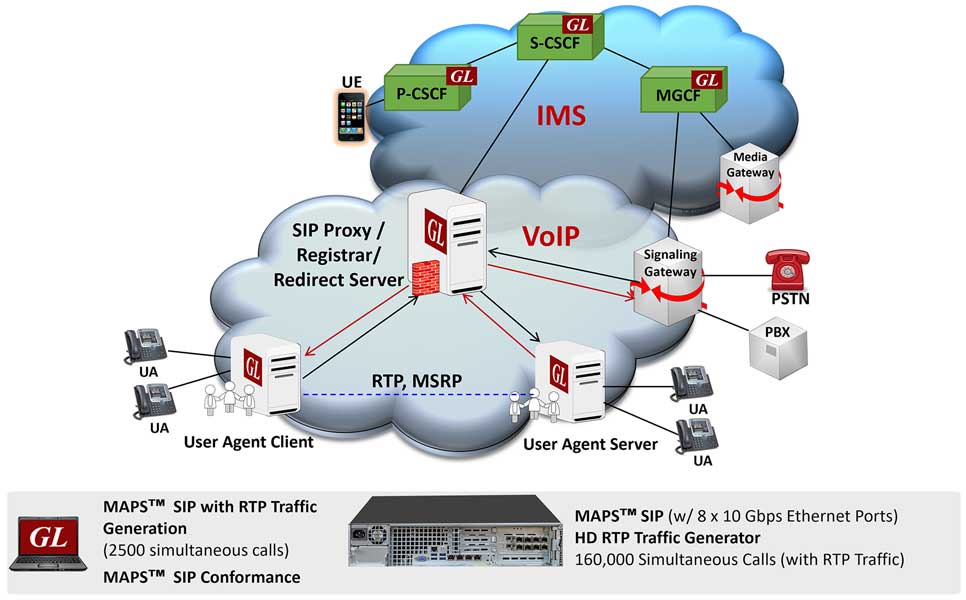GL Enhances Session Initiation Protocol Emulator
Welcome to the latest issue of GL's Newsletter providing information and insight into our MAPS™ Session Initiation Protocol (SIP) Emulator that helps users to generate and receive SIP Signaling with traffic. In this newsletter, we highlight the important enhancements for MAPS™ SIP software version 22.3.30.

Overview
GL's MAPS™ SIP emulator is enhanced with the following:
- Python Application Programming Interface (APIs) now supports
- T.38 fax emulation and fax tone negotiation
- Insert RTP impairments in run-time
- Feature with configurations to insert proprietary SIP headers in run time
- Automated the SUBSCRIBE transaction upon successful User Agent registration
- RTP Statistics log includes call detail record information for each call
GL's Message Automation & Protocol Simulation (MAPS™) is a versatile software program that can emulate a wide variety of telecommunications protocols. MAPS™ for SIP can emulate User Agents (User Agent Client- UAC, User Agent Server-UAS), Proxy, Redirect, Registrar and Registrant servers. It can emulate any interface in the VoIP network. It can place and answer calls just like an actual VoIP phone. All call parameters are customizable including calling number, called number, duration, audio payload and more. MAPS™ SIP can also be used in conjunction with MAPS™ RTP HD hardware appliance to generate tens of thousands of simultaneous calls using specialized Network Interface Cards.
GL’s MAPS™ SIP test tool/traffic generator can emulate any interface in a SIP network (standard SIP, SIP - I (ISUP), SIP IMS, and SIP MSRP), and perform SIP Protocol Conformance Testing (of SIP protocol implementations). SIP is also used in ED-137, the next generation Air Traffic Control system.
Main Features
- Signaling
- Generates and processes SIP valid and invalid messages
- Supports IPv4 /IPv6 and transport over UDP and TCP, and TLS for secure transport
- Supports joining a conference call, unattended call transfer, attended call transfer, call hold, auto call rejection, early media, and silence packets generation
- Ability to implement IP Spoofing for any network like Class C, Class B, etc.
- Supports in dialog and out of dialog transactions for SUBSCRIBE, NOTIFY, OPTIONS, REFER, and INFO SIP methods
- Supports generation of custom SIP messages and call scenarios
- Traffic
- Supports transmission and detection of various RTP traffic such as digits, voice file, single tone, dual tones, IVR, FAX, and Video in IP networks
- Supports almost all industry-standard codec types - G.711 (mu-Law and A-Law), G.722, G.729, G.726, GSM, AMR, AMR -WB, EVRC, EVS, OPUS, SMV, iLBC, SPEEX, and more. *AMR, EVRC, EVS, and OPUS variants require additional licenses
- Supports Secure Real-time Transport Protocol (SRTP)
- Provides Voice Quality statistics such as Mean Opinion Score (MOS), Packet loss, and Jitter
- Supports both RTP G.711 Pass-Through Fax and T.38 emulation over IP
- Message Session Relay Protocol emulation (MSRP) supporting instant messaging
- Supports Interactive Voice Response (IVR) testing that recognizes and responds to voice prompts using DTMF digits or voice, allowing automated IVR traversal and testing
- Supports Short Message Service (SMS) over IP/ IP Multimedia Subsystem (IMS) communication, SMS is encapsulated in a SIP message and carried over IMS core network
- API / CLI
- MAPS™ CLI interface based on a client-server model allows users to control all features of MAPS™ through APIs
- Supported clients include Python, Java, TCL and others
Applications
- Fully integrated, complete test environment for SIP
- Supports end-to-end gateway testing
- Supports conformance testing UAC, UAS, Proxy, Registrars, Registrants, Redirect Servers, and other SIP entities
- Functionality and load testing on SIP entities like Proxy, Registrar, IP PBX, B2BUA, VoIP Gateways, IP Phones, etc.
- Testing NG9-1-1 emergency services (voice and text) and components within the ESInet
 Back to Newsletter Index Page
Back to Newsletter Index Page